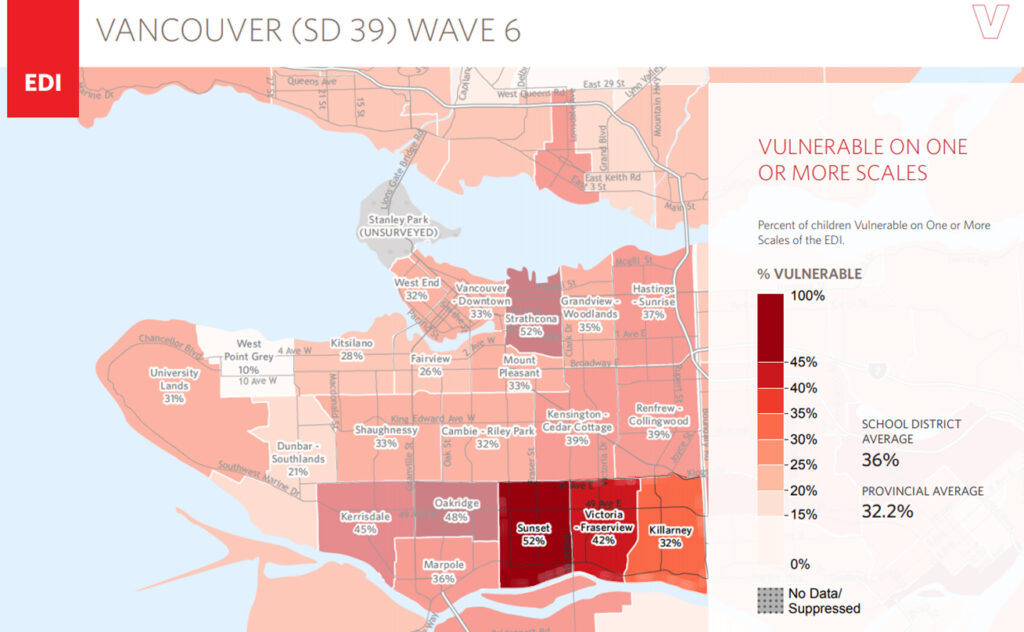South Vancouver, often viewed as a single section of Vancouver, actually encompasses three distinct neighbourhoods, each with unique demographics and needs.
A Community with Distinct Needs
Home to nearly 100,000 people, South Vancouver has the City of Vancouver’s highest proportion of racialized residents (80%) and immigrants (56%). The region is home to many young families and seniors living in multigenerational households, yet it has a limited number of social service hubs. These factors create a unique set of challenges for the children and families in South Vancouver, which the South Vancouver Neighbourhood House (SVNH) has been addressing through data-driven, community-informed approaches.
Identifying Gaps Through EDI Data
SVNH was an active member of the Vancouver Early Years Partnership (VEYP), a network that collaborated to promote early years programs and services and used Early Development Instrument (EDI) and other data sources to better understand and address children’s developmental needs. With the release of Wave 6 EDI data (collected 2013-2016), SVNH and its executive director at the time, Zahra Esmail, noted that while South Vancouver was often viewed as a single area of Vancouver, it encompassed three distinct neighbourhoods: Killarney, Victoria-Fraserview, and Sunset. Each neighbourhood had different concentrations of children, gaps in services, and areas with higher prevalence of developmental vulnerabilities. Recognizing these diverse needs across South Vancouver prompted the creation of more accessible programming to meet families where they were.

Meeting Families Where They Are: New Outreach Programs
One of the EDI data-informed initiatives SVNH established involved a series of early years outreach programs, taking place directly in local parks and community spaces across the three neighborhoods. These “pop-up” style programs made it easier for families to participate, reducing barriers such as transportation, while fostering a sense of community in accessible, familiar environments. Efforts were made to connect with community leaders and to increase visibility of neighbourhood languages and cultures.
The outreach programs also focused on social-emotional learning and connecting families to resources and support, addressing the vulnerabilities identified in the EDI data. As these programs grew in popularity, SVNH successfully secured funding for more early years programming – extending support across the community.
This foundational work set the stage for ongoing efforts under the current Executive Director leadership of Mimi Rennie, Esmail’s successor.
Advocating for Systemic Change
SVNH teamed up with the Community Research and Engagement (CoRE) Lab at the University of British Columbia, led by HELP faculty member Dr. Brenda Poon, to further explore the multiple influences on, and systems involved with supporting, children’s early social and emotional development. They are currently co-developing a community-based participatory action research program that emphasizes and promotes community strengths and engagement to connect marginalized families in the community to needed supports and services.
The Urban Studies Program and Faculty of Health Sciences at Simon Fraser University supported SVNH and Marpole Neighbourhood House (MNH) to do a neighbourhood equity analysis. The findings, outlined in the South Vancouver and Marpole Neighbourhood Equity Report, highlight differences in funding opportunities, transportation availability, social and health infrastructure between South Vancouver and other areas of the city.
Building on the initial exploration of the early years context, SVNH also consulted Middle Years Development Instrument (MDI) data and strengthened opportunities for youth engagement, participation and leadership in these processes. These efforts revealed that South Vancouver has a growing youth population with unique needs that aren’t being fully met. Unlike other parts of Vancouver, South Vancouver lacks a centralized youth hub, leaving young people with limited resources and programming options, and a sense of belonging in their neighbourhood. Drawing on the City of Vancouver’s Building Safer Communities Program, SVNH has used MDI data and community data to advocate for change at the municipal level.
Community members were invited to share their experiences at city council meetings, drawing attention to the systemic underfunding and lack of infrastructure in South Vancouver. These efforts have already prompted the City of Vancouver to respond around transportation issues and funding to continue relationship and community-building efforts between the City and South Vancouver communities.

A Broader Vision: Building Equity and Fostering Community Leadership
By documenting the challenges that children and families in South Vancouver face, EDI and MDI data helped SVNH make a compelling case for equitable investment in South Vancouver’s infrastructure and services. The ongoing collaboration between SVNH, and various academic partners exemplifies how data and research can drive community-led solutions, enabling families to thrive, and shaping policy and programs for lasting change. Through their extensive and ongoing community engagement and development efforts, SVNH is helping to build a more equitable future for South Vancouver’s families.
Learn More: South Vancouver Neighbourhood House